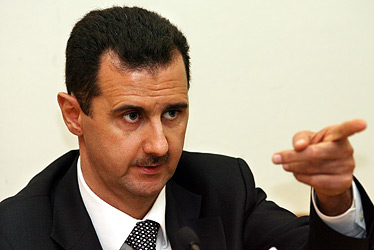
The Muslim Brotherhood and other Islamist factions staged hit-and-run attacks against government buildings and officials in the early 1980s and almost succeeded in killing the president of a country that has remained eerily quiet during the geopolitical tsunami that is still sweeping the Arab world. You’re supposed to guess which country.
The president was on an official state visit to Mali when he ducked a burst of AK-47 fire and then kicked a hand grenade to one side before hurling himself under a table — and survived with a few metal fragments in his legs.
Revenge was swift. Hours later, almost 1,000 Islamist prisoners killed in their cells by units loyal to the president’s brother, Rifaat.
No sooner did word of the massacre reach Umar Jawwad (aka Abu Bakr), a local guerrilla commander, than messages went out by radio to roof-top snipers to kill government soldiers.
Next Abu Bakr radioed the code for a general uprising in the city. From the minarets the call to prayer became the call to jihad against the government, everything from torching the homes of government officials to attacking police posts and ransacking armories.
The Arab head of state, a former air force chief, decided the time was at hand for massive retaliation, the likes of which the Middle East hadn’t seen since the Crusades.
In the first week of February 1982, the president mobilized 12,000 troops, including 200 tanks, all the army’s special forces and other elite units and Mukhabarat agents. Through loudspeakers that ringed the city, the government warned that anyone who didn’t leave immediately would be considered an insurgent and killed with no further questions.
Syria’s President Hafez al-Assad and his brother Rifaat, in command of all Special Forces, decided to level the city of Hama, a Muslim Brotherhood stronghold, by carpet bombing it first. The air bombardment lasted three days. The narrow streets that hampered armored movements were flattened. But when there was still resistance after the blitzkrieg, the Assad brothers ringed Hama with artillery and shelled it until there was very little left.
The few survivors were lined up against walls and executed. Later Rifaat bragged to friends they had killed at least 38,000. It was genocide by any definition.
In 2003, 20 years later, Syrian journalist Subhi Hadidi wrote that the siege of Hama, under the command of Gen. Ali Haydar, lasted 27 days under constant artillery and tank fire before invading it and that up to 40,000 of the city’s inhabitants were killed in the siege. Some 15,000 are still missing. And the city was leveled to the ground and rebuilt.
Before Assad staged his 1970 coup, Syria had experienced 21 coups since the end of the French mandate in 1945. Assad clung to power for almost 30 years, including the 1973 defeat by Israel. But his rule was bloody. Both before and after Hama, some 70,000 are estimated to have been killed in dozens of punitive raids against Islamist militants.
On Oct. 23, 1983, a Syrian intelligence service was the prime suspect in the truck bomb attack that killed 242 U.S. Marines in their Beirut barracks and of 58 French soldiers. U.S. President Ronald Reagan immediately decided to evacuate remaining U.S. troops — and two days later he ordered the invasion of Grenada.
Hafez Assad’s son Bashar, a former ophthalmologist trainee living in London, inherited the presidential mantle at 34 after his father died of a heart ailment in 2000. Today life appears to be almost normal. But 14 different intelligence and security organizations keep a tight lid on society.
The assassination of Lebanese President Rafik Hariri in 2005 was blamed on one of the Syrian intelligence services but never proved. The international outcry led to the withdrawal of Syria’s de facto occupation troops that had originally moved in to protect the Christians against the Muslims in Lebanon’s civil war (1975-90).
The civil war lasted 15 years, killed 250,000, wounded 1 million, half of them with lifetime disabilities.
Today, Iran’s surrogate Hezbollah rules the Lebanese roost and managed to maneuver its own candidate into the prime minister’s job.
How Syria has escaped the current Arab upheaval is probably a function of a tightly run police state. But maybe not much longer.
Messages on an Internet social networking site called for nationwide demonstrations in Syria against President Bashar al-Assad in "a time to be set within days." Some 25,000 people joined the group that brands itself, "The Syrian revolution against Bashar al-Assad 2011."
The organizers called for "peaceful protests" across Syria and other Arab nations to demand the fall of the regime. Now 45, Assad has carefully cultivated his image as a resistance fighter against U.S. imperialism and its Israeli colony.
Syria’s constitution allows only Baath Party rule. But the revolutionary mythology rings hollow and has petered out.
Arnaud de Borchgrave, a member of the Atlantic Council, is editor-at-large at UPI and the Washington Times. This column was syndicated by UPI. Photo credit:
Image: assad.jpg
